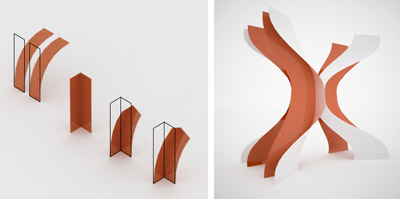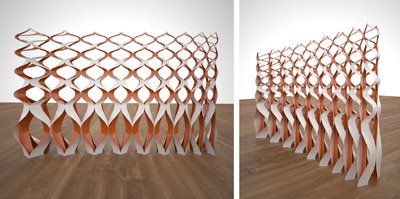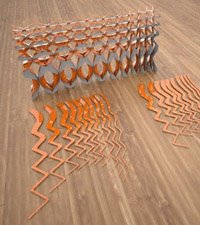Here is a link to the 45 minute tutorial video.
Saturday, June 28, 2008
Rhino Tutorial 003
Rhino Tutorial 002
Here is a link to the tutorial video.
Friday, June 27, 2008
Rhino Tutorial 001
Here is a link to the tutorial.

Thursday, June 26, 2008
Digital Project Honeycombs
 Then as the individual cell is made larger or smaller than the average size, it is made deep/shallow or thick/think. This variation is visible in the iterations below. This level of analysis adds a level of removal from the designer. One cannot be sure where the depth will shift.
Then as the individual cell is made larger or smaller than the average size, it is made deep/shallow or thick/think. This variation is visible in the iterations below. This level of analysis adds a level of removal from the designer. One cannot be sure where the depth will shift.  Variations are rendered to give some sense of the range of variation possible. I will be gearing up for class in the fall and will post tutorials on document templates and rule firing, check back.
Variations are rendered to give some sense of the range of variation possible. I will be gearing up for class in the fall and will post tutorials on document templates and rule firing, check back.Monday, June 23, 2008
Point Distance Surface
Making a few tweeks with the sliders and then baking each, the variations from a screen shot below. Unfortunately I could not find a way to trim in grasshopper so this task is completed once the geometry is baked.


Revised file based on some feedback from Gabe. My trim is a bit messy because I could not get it to subtract the correct side. I exploded the surfaces to get the final trim. Here is a link to the grasshopper file.

Sunday, June 22, 2008
Grasshopper Surface Studies
 The loft surface is built through a series of sin and cos curves, where the frequency is controlled by the variables (detail of the relationships below).
The loft surface is built through a series of sin and cos curves, where the frequency is controlled by the variables (detail of the relationships below). Here are 4 sample surfaces made through slight modifications of the slider bars.
Here are 4 sample surfaces made through slight modifications of the slider bars. The surface is then contoured to approximate a milled pattern.
The surface is then contoured to approximate a milled pattern.

As a variation of the simple surface, it gets slightly submerged into the stocck material, leaving a flat surface on the top with the remaining surface being milled. This reduces the material thickness and milling time.

Saturday, June 21, 2008
Polar Array Framework
The crossing points of the framework are used as the input points for the cell. A central point is used to control the polar array and distort the framework.
Thursday, June 19, 2008
Sheet Metal Screen Wall

The parts spread as they move horizontally and thin as they move vertically.

Another key aspect of this research is in the investigation of material efficient form that can be completely nested on a flat sheet. While this project is not zero waste, one can see the potential of cutting such forms from a flat sheet.



